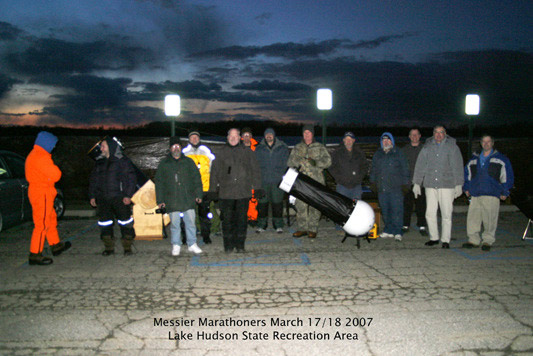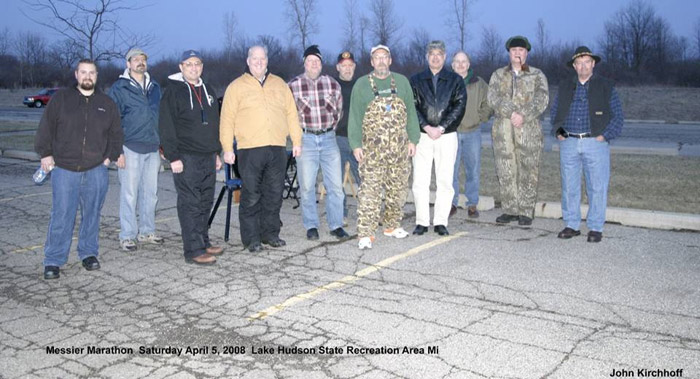
Messier Marathon.
by John Kirchhoff
Printed in Reflections: March, 2010.

Messier Marathoners, March 17/18, 2007. Lake Hudson State Recreation Area, Michigan.
The Messier Marathon is the amateur astronomer’s equivalent to the
proverbial “all nighter” before an important
exam. This year I will be participating in my third straight all night
attempt to see just how many M objects
I can check off my list between sunset and sunrise March 13/14 at Lake
Hudson State Recreation Area.
Here are a few tips you might find useful if you decide to participate
in the Marathon.
-
Location! You will need a dark sky location with an excellent west horizon
to catch the early setting
objects and an east/southeast horizon to net the last five M’s just
before dawn. I have never heard of
anyone picking up the last Messier M30, from our latitude in mid March.
Every other M can be observed.
Lake Hudson offers dark skies and an excellent horizon.
-
Know your Field Of View and orientation of finder to the telescope.
I prefer using a Telrad reflex
finder because the heads up display and that the view is not magnified
or flipped. It’s really easy to get
confused when you are tired!
-
Practice! It’s not too soon to locate the early setting Messier
right now while the Marathon is still a
couple of weeks away. One of the most difficult targets is M-74, a face
on galaxy in Pisces. You need
to be very familiar with it’s location and surrounding star fields
if you expect to have ANY chance of
seeing it in mid March. M-74 tends to blend into the background sky even
under good conditions... its’
nickname, the Phantom Galaxy, is well deserved. M-77, M-33 and the two
satellite galaxies associated
with M31, 32 and 110 are also difficult in a not totally dark sky. Two
years ago I made my first attempt
to muddle through the Virgo cluster for the first time running the Marathon.
I was able to do it but it
took three tries before I could positively identify all the members of
the cluster. It would have been a
lot easier to practice ahead of time first! It’s too early to practice
locating the late risers... M-15, 2,
72, 73 ...30. Best to try to see them in early April and keep your notes
for next year!
-
Rest up, bring snacks and layer up! Two years ago I really ran into
a wall after completing the Virgo
cluster around 3 am. I was able to recover because I remained warm, had
plenty of snacks, and had a
good night’s sleep the day before. Last year I didn’t make it
to morning because I had worked late the
day before and didn’t bring enough clothes. I ended up getting cold
by 2 am and was in bed by 3. Coffee,
tea and hot chocolate are a must!
-
Have a plan! I use a Messier Marathon Log that I picked up off the Internet
that arranges the M’s in
observing order and Harvard Pennington’s “The Year-Round Messier
Marathon” book (available from
Willmann-Bell). I also use the Orion Deep Map 600 as a backup.
-
Last but not least observe with buddies! Your friends will keep you
going when you might want to
throw in the towel.
This year I plan on using a pair of 20X80 binos for the Marathon. Binoculars
offer great contrast, are less fatiguing
on the eyes and the 80’s should let me see just about every M on the list.
I hope you find my tips useful and look forward to seeing you out at Lake
Hudson March 13/14 for the Marathon.

Messier Marathon, Saturday April 5, 2008. Lake Hudson State Recreation Area, Michigan.
Links
Copyright Info
Copyright © 2015, the University Lowbrow Astronomers. (The University Lowbrow Astronomers are an amateur astronomy club based in Ann Arbor, Michigan).
This page originally appeared in Reflections of the University Lowbrow Astronomers (the club newsletter).
This page revised Tuesday, April 10, 2018 7:08 PM.
This web server is provided by the University of Michigan;
the University of Michigan does not permit profit making activity
on this web server.
Do you have comments about this page or want more information about the club? Contact Us.



